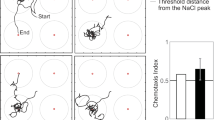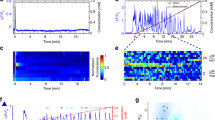Abstract
The anatomical connectivity of the nervous system of the nematode Caenorhabditis elegans has been almost completely described, but determination of the neurophysiological basis of behavior in this system is just beginning. Here we used an optimization algorithm to search for patterns of connectivity sufficient to compute the sensorimotor transformation underlying C. elegans chemotaxis, a simple form of spatial orientation behavior in which turning probability is modulated by the rate of change of chemical concentration. Optimization produced differentiator networks capable of simulating chemotaxis. A surprising feature of these networks was inhibitory feedback connections on all neurons. Further analysis showed that feedback regulates the latency between sensory input and behavior. Common patterns of connectivity between the model and biological networks suggest new functions for previously identified connections in the C. elegans nervous system.
Similar content being viewed by others
References
Bargmann CI, Horvitz HR (1991) Chemosensory neurons with overlapping functions direct chemotaxis to multiple chemicals in C. elegans. Neuron 7: 729–742.
Chalfie M, Sulston J, White J, Southgate E, Thomson J, Brenner S (1985) The neural circuit for touch sensitivity in C. elegans. J. Neurosci. 5: 956–964.
Davis RE, Stretton AOW (1989a) Passive membrane properties of motorneurons and their role in long-distance signaling in the nematode Ascaris. J. Neurosci. 9: 403–414.
Davis RE, Stretton AOW (1989b) Signaling properties of Ascarismotorneurons: Graded active response, graded synaptic transmission, and tonic transmitter release. J. Neurosci. 9: 415–425.
Dusenbery D (1980) Responses of the nematode C. elegansto controlled chemical stimulation. J. Comp. Physiol. 136: 127–331.
Goodman M, Hall D, Avery L, Lockery S (1998) Active currents regulate sensitivity and dynamic range in C. elegansneurons. Neuron 20: 763–772.
Kerr R, Lev-Ram V, Baird G, Vincent P, Tsien RY, Schafer WR(2000) Optical imaging of calcium transients in neurons and pharyngeal muscle of C. elegans. Neuron 26: 583–594.
Lockery SR, Goodman MB (1998) Tight-seal whole-cell patch clamping of C. elegansneurons. Methods Enzymol. 293: 201–217.
Munro E, Shupe L, Fetz E (1994) Integration and differentiation in dynamical recurrent neural networks. Neural Comput. 6: 405–419.
Nickell W, Pun R, Bargmann C, Kleene S (2002) Single ionic channels of two C. eleganschemosensory neurons in native membrane. J. Membr. Biol. 189(1): 55–66.
Pierce-Shimomura JT, Morse TM, Lockery SR (1999) The fundamental role of pirouettes in C. eleganschemotaxis. J. Neurosci.19: 9557–9569.
Press W, Teukolsky S, Vetterling W, Flannery B (1992) Numerical Recipes in C. 2nd edn Cambridge University Press, New York.
Riddle D, Blumenthal T, Meyer B, Priess J (eds) (1997) C. elegans II. Cold Spring Harbor Labratory Press.
Rutherford T, Croll N (1979)Wave forms of C. elegansin a chemical attractant and repellent and in thermal gradients. J. Nematol. 11: 232–240.
Tsalik L, Hobert O (2003) Functional mapping of neurons that control locomotory behavior in C. elegans. J. Neurobiol. 56: 178–197.
Ward S (1973) Chemotaxis by the nematode C. elegans: Identification of attractants and analysis of the response by use of mutants. Proc. Natl. Acad. Sci. USA 70: 817–821.
Ward S, Thomson N, White JG, Brenner S (1975) Electron microscopical reconstruction of the anterior sensory anatomy of the nematode C. elegans. J. Comp. Neurol. 160: 313–338.
White J (1985) Neuronal connectivity in C. elegans. Trends Neurosci. 8: 277–283.
White JG, Southgate E, Thomson JN, Brenner S (1986) The structure of the nervous system of the nematode C. elegans. Philos. T. Roy. Soc. B [Biol.] 314: 1–340.
Zheng Y, Brockie PJ, Mellem JE, Madsen DM, Maricq AV (1999) Neuronal control of locomotion in C. elegansis modified by a dominant mutation in the glr-1 ionotropic glutamate receptor. Neuron 24: 347–361.
Author information
Authors and Affiliations
Rights and permissions
About this article
Cite this article
Dunn, N.A., Lockery, S.R., Pierce-Shimomura, J.T. et al. A Neural Network Model of Chemotaxis Predicts Functions of Synaptic Connections in the Nematode Caenorhabditis elegans . J Comput Neurosci 17, 137–147 (2004). https://doi.org/10.1023/B:JCNS.0000037679.42570.d5
Issue Date:
DOI: https://doi.org/10.1023/B:JCNS.0000037679.42570.d5




